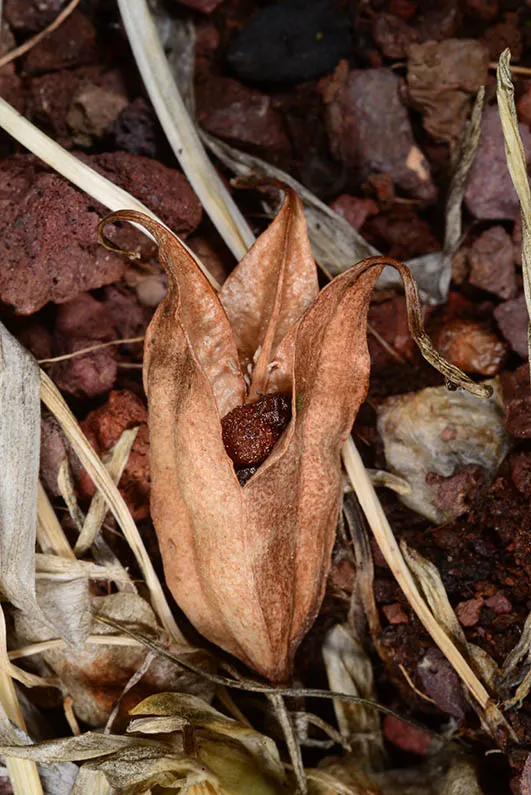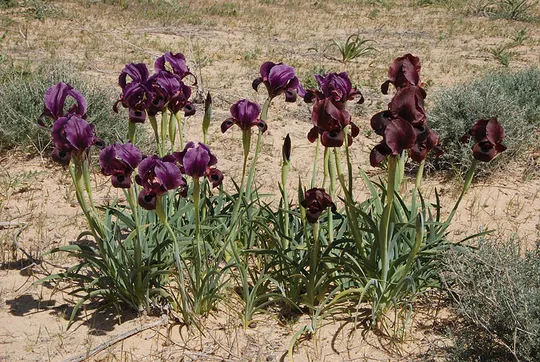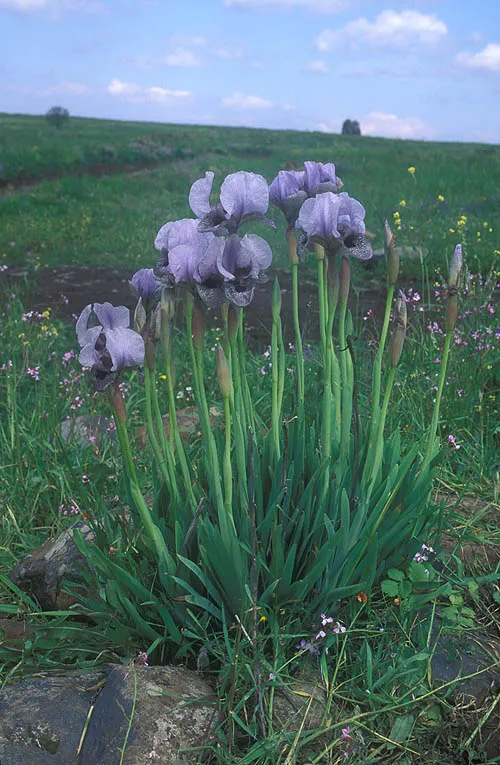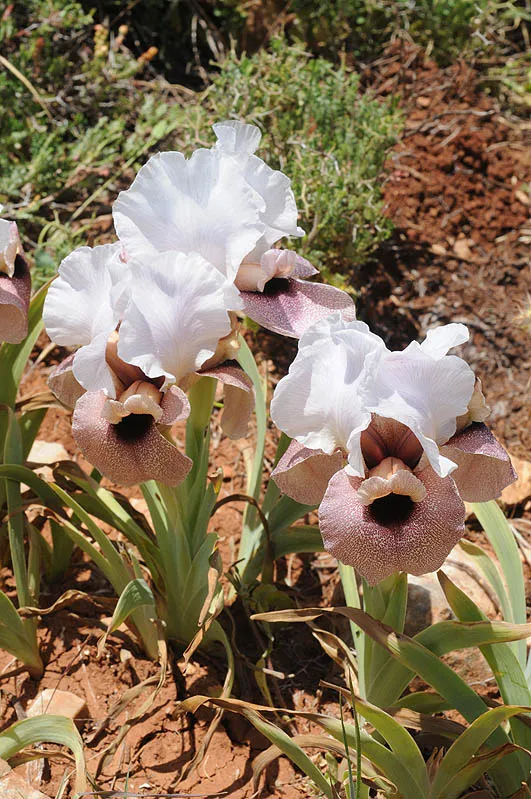Dark-brown Iris, Judean Iris
Iris atrofusca
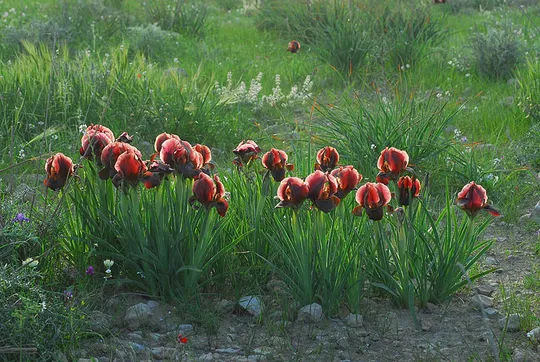
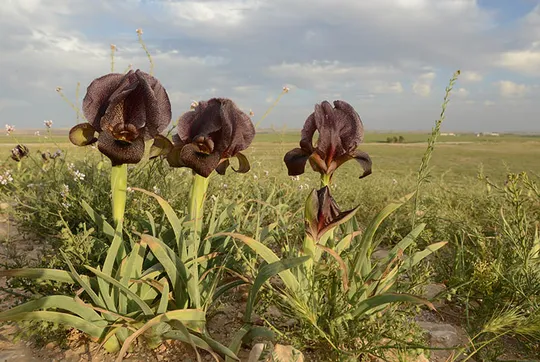
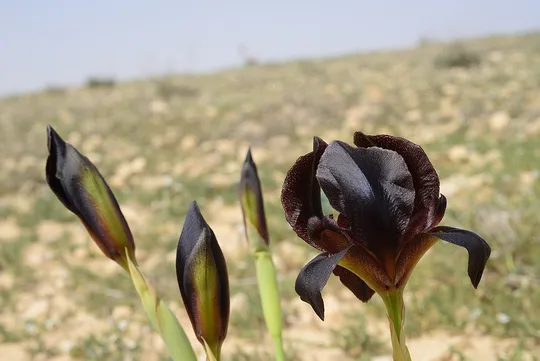
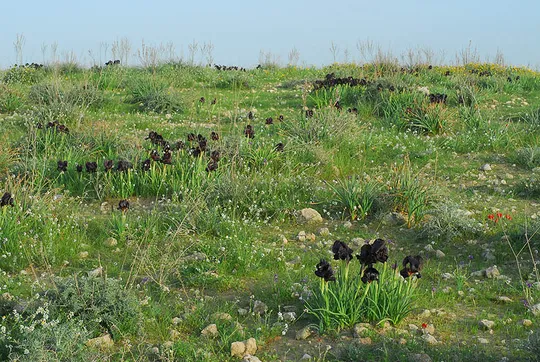
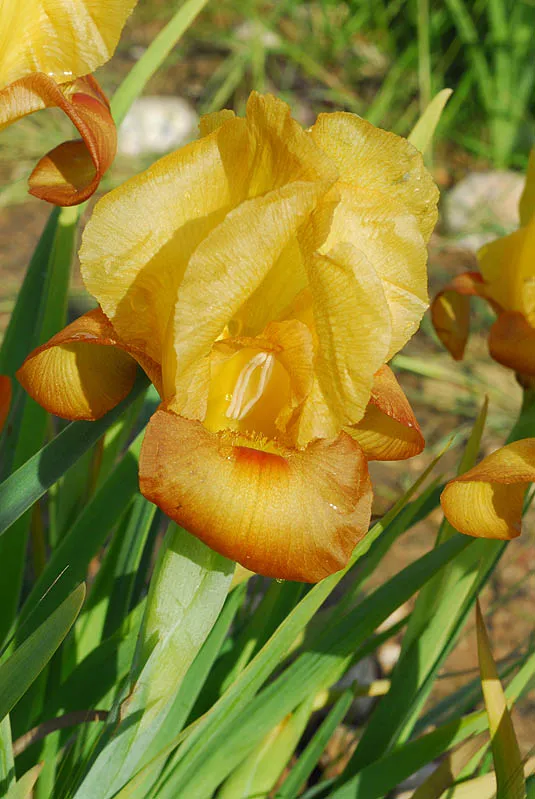
Iris atrofusca is a geophyte in the Iris section Oncocyclus. Its height is 35-50 cm. The leaves are organized in a fan shape, overlapping each other. The leaves are flattened, sword-like, straight and not curved (unlike Iris petrana). It grows in clumps that include many shoots. The flower is large, about 8 cm in diameter, and its height is greater than its width. The perianth color changes by population from black to dark purple to veined violet. It blooms at the beginning of March at low altitudes, such as the Goral Hills near Be’er Sheva, and at the end of March at higher altitudes, e.g. the Rimonim Junction. In the Arad Valley, there are populations that sometimes continue blooming until mid-April.
Iris atrofusca grows in the southern Golan, the Gil'ad
mountains in Jordan, the Mediterranean-Desert ecotone in the Judean Mountains
and the southern Samarian Desert, the Judean Desert, the northern Negev, Arad
Valley, Mount Yatir, the Lahav Hills area until Lehavim Junction. In the past it
was also found in Dahariya.
In the Samarian Desert, a large concentration was found in the area of
the upper tributaries of Wadi Makuk and Wadi Uǧa, as
well as on the slopes of Kohav HaShahar and Rimonim Junction, at higher
altitudes of 400-700 m. From Ma’ale Mikhmas to the Ma'on Ridge, there is a
large gap in its range, except for a lone population on the Wadi Tko'a cliffs,
near the Haritun Cave, and a small population at the edge of the village of
Bani Na’im. A population was once spotted in the past, near Ma’ale Amos (Kanub
Ruins), but it is apparently extinct due to overgrazing. Recently, Oz Golan
discovered additional populations on the Ma'on Ridge (at Wadi Wa’ar at the foot
of the Carmel, and near Zif). In the northern Arad Valley and the Tel Krayot
Reserve on Mount Amasa, there are large populations along a geographic arch through
Sansana, Goral Hills and northward up to the Lehavim Junction.
Rocky limestone slopes
in ecotones with a precipitation of 200-370 mm, on limestone rocks and terra
rossa soil, in loess soil and gray soils on Neogenic conglomerate.
Iris atrofusca belongs to a vicarious set of royal irises,
all of which have very dark flowers and yellow beards. Their distribution is
allopatric, and they grow in the ecotone extending from the southern Golan to
the Gilboa and the Samarian ecotone south to the Arad Valley, Yeruham Valley and
Lahav Hills. One species in the set (Iris atropurpurea) has even
“invaded” the coastal plain. Iris haynei grows in the north, Iris
atrofusca in the central region and Iris petrana in the south.
According to Sapir et al., the transition between the species is continuous and
all of the species, including the Jordan species (except for Iris mariae,
which has a black beard and bluish standard) could be united into one species –
Iris atrofusca.
Iris atrofusca, in its limited
format, is very similar to Iris haynei, but their distribution does not
overlap – while Iris atrofusca grows from the Binyamin ecotone
(Rimonim Junction) southward down to the Arad Valley, Iris haynei grows
in the Samarian ecotone (Wadi Firan ) and in the Gilboa. The southern Golan populations,
which were identified as Iris haynei are in fact Iris atrofusca. In
the Arad Valley area, Iris atrofusca gradually becomes Iris petrana.
The flowers become smaller and the leaves become arched, scythe-like.
·
The
expansion of Be’er Sheva has severely affected the Iris
populations at Goral Hills and near the Negev Brigade Monument, and they are almost
completely extinct. Overgrazing suppresses the populations and could to lead to
extinction. Development of transportation infrastructure (train and roads) and
the preparation of land for afforestation critically disturbed the populations
on Goral Hills.
·
Grows
in distinct, very fragmented patches.
·
The
threat in Israel is global, because the species is endemic to Israel and
northern Jordan.
Grazing should be
limited, as intense grazing destroys shoots, flowers and foliage. The land
should be left bare of trees or other shade-creating factors and be protected
from all-terrain vehicles.
This is the most widely
distributed species of all of the royal irises in the Levant. It is endemic to Israel and northern Jordan. The
demarcation of its distribution area is also dependent on the definition of the
“scope” of the species and the taxonomic status of closely related species.
The taxonomic definition
of Iris atrofusca as a broader or limited taxon affects the definition
of its distribution borders and the number of its populations. Nevertheless,
the species is clearly a sub-endemic, very attractive species, which grows in a
patchy, very fragmented pattern and is one of the most beautiful and important
plants for preservation. Nature protection in Israel has led to the
rehabilitation of many ecotone populations in Judea and Samaria, although most
of them are not included in nature reserves, and many are under Palestinian
control, subject to heavy grazing pressure, which as of now is not destructive.
Current Occupancy Map
| 1000 squre meter pixel | 5000 squre meter pixel | 10000 squre meter pixel | |
|---|---|---|---|
| number of observations | 0 | 0 | 0 |
| in total pixels | 0 | 0 | 0 |
| Family | Iridaceae |
| Classification | On the endangered species list |
| Ecosystem | Semi-Steppe Belt |
| Chorotype | Western Irano-Turanian |
| Conservation Site | Wadi Mar'it – In the Western Part of Arad Valley, Rimonim Junction or Kohav HaShahar |
| Rarity |
1
1
6
|
|---|---|
| Vulnerability |
0
0
4
|
| Attractiveness |
0
3
4
|
| Endemism |
0
3
4
|
| Red number |
1
4.2
10
|
| Peripherality | N |
| IUCN category | DD EW EX LC CR EN VU NT |
| Threat Definition according to the red book | Endangered |
 Based on:
Based on:
